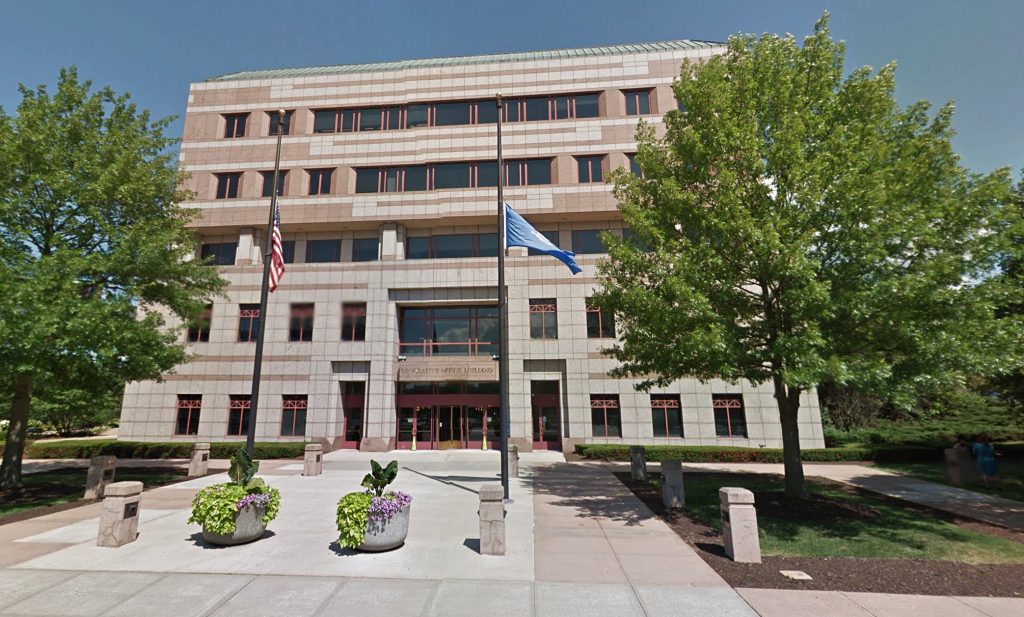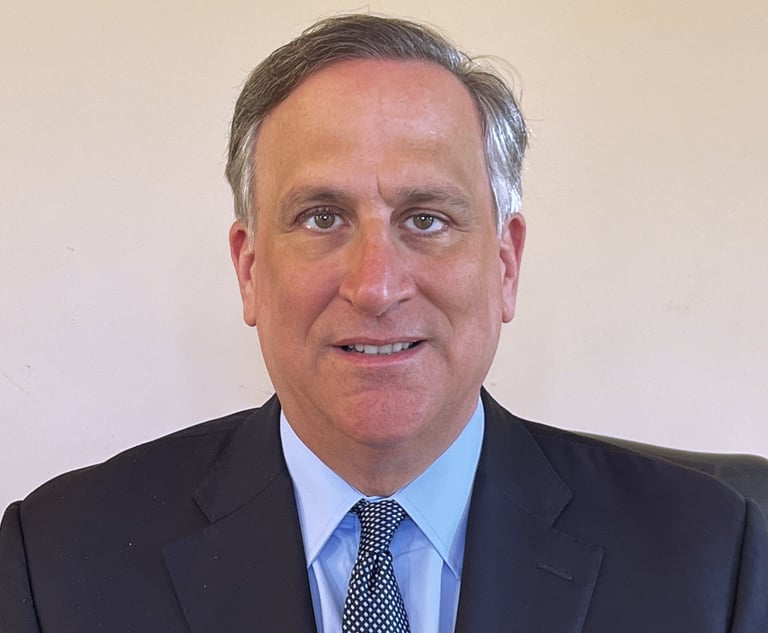Don't Miss Another Opportunity To Fix Sex Offender Registry
Connecticut should change to the recommended risk-based registry, as used in New York, Massachusetts, Rhode Island and some 13 other states.
October 25, 2019 at 02:54 PM
5 minute read
 Connecticut Legislative Office Building.
Connecticut Legislative Office Building.
Last session, the state Legislature missed an opportunity to make major changes in Connecticut's sex offender registry by failing to pass Senate Bill 1113 as proposed by the state Sentencing Commission.
The Sentencing Commission was required by the Legislature to examine Connecticut's sex offender registry and propose changes to the Legislature by 2018.
In order to comply with the Legislature's request, the commission set up a special subcommittee to study the effectiveness of the current registry. The subcommittee—a total of about 40 people—had representatives from all the stakeholders, including state and local police, the state attorney's office, Department of Corrections, Board of Pardons and Parole, the judiciary branch, victims' advocates and others.
The Sentencing Commission spent two years of study, including numerous public hearings and testimony by nationally known experts on treatment of sex offenders, as well as experts on how other state registries operate. The Sentencing Commission then, with almost unanimous agreement, produced a report recommending major changes in Connecticut's sex offender registry laws. The changes were contained in SB 1113.
Those changes would have resulted in a smaller, more focused and enforceable registry. They also would have lessened the barriers to successful re-integration into the community for low-risk offenders. The 204-page report was adopted by the full Sentencing Commission and submitted to the Judiciary Committee in December 2017.
Under current law, sex offenders who have served their sentences are released back into the community. They must register on the public registry for either 10 years or life, depending upon the offense they committed. This is known as an "offense-based" registry. The registry is operated by the state police. Unfortunately, the registry doesn't distinguish between high-risk offenders and low-risk offenders. It includes the picture and address of every registered offender. It is searchable by the general public. And anyone can obtain a list of sex offenders residing in their town, or within 2,500 feet of their house, or on their street.
The existence of a sex offender registry creates a false sense of security by making people believe that the sex offenders on the registry are subject to supervision. However, there is no supervision connected to the registry. The only thing the registrants have to do to stay in compliance is to respond by mail to a quarterly change of address request.
Connecticut's current sex offender registry was established in 1998. It had less than 300 registrants. The registry grows every year because half of the new registrants are placed on the registry for life. Those listed for 10 years are removed from the registry at the end of their registration terms, and those with lifetime registry are never removed, so the numbers keep growing. The registry now contains more than 6,000 names. Virtually every town in the state has registered sex offenders. The city of Hartford has more than 700.
Every state has a sex offender registry, but 16 states have "risk-based" registries. This means a special board evaluates each sex-offender's risk of re-offending and sets the length of time the offender would be listed on any registry. Risk-based registries are used in New York, Massachusetts, Rhode Island and some 13 other states.
In addition, many states that have risk-based systems have registries for low-risk offenders that are not accessible to the public.
Virtually every state has a process for an offender to apply for removal from the registry. SB 1113 would change Connecticut from offense-based to a risk-based registry state. It would create a new board to do risk assessments. Upon release from jail, individuals would be placed on a registry for 10, 20 years or life, depending on their risk of re-offending. The low-risk offenders would be placed on a law-enforcement only registry, leaving the high-risk offenders subject to public scrutiny. Offenders would be able to apply for early removal from the law-enforcement only registry.
SB 1113 contained changes proposed by the Sentencing Commission that would update, modernize and increase the usefulness of the Connecticut sex offender registry. The Judiciary Committee raised SB 1113 for hearing, and the bill was passed by both the Judiciary and Appropriations Committees, but the session ended before it could be passed.
Some major changes in the proposed bill included,
1) Reducing the frequency of reporting for low-risk offenders.
2) Allowing offenders to apply for removal from the registry, as allowed in virtually every other state.
3) Creating a process for removal of ex post facto registrants from the registry. The most serious flaw with the current registry is that offenders were retroactively placed on the registry years after their conviction, arguably violating the ex post facto clause of Article 1 of the U.S. Constitution.
4) Allowing all of the low-risk individuals to earn a right to petition the court for removal from the registry, thus making it easier for them to reintegrate into the community. To be eligible for early removal an individual would have to be in complete compliance with the registry's requirements.
5) Reducing the demand on police services by allowing police to focus their time dealing with high-risk registrants who are out of compliance. Because low-risk registrants would have an incentive to comply with registry requirements, in order to be eligible for removal from the registry, there would be fewer violations and fewer warrants for people out of technical compliance.
Hopefully the Sentencing Commission will re-submit SB 1113, its well-researched, broadly debated, and carefully drafted proposal for reforming the registry in the coming session, and it will be enacted by the Legislature.
This content has been archived. It is available through our partners, LexisNexis® and Bloomberg Law.
To view this content, please continue to their sites.
Not a Lexis Subscriber?
Subscribe Now
Not a Bloomberg Law Subscriber?
Subscribe Now
NOT FOR REPRINT
© 2025 ALM Global, LLC, All Rights Reserved. Request academic re-use from www.copyright.com. All other uses, submit a request to [email protected]. For more information visit Asset & Logo Licensing.
You Might Like
View All
ADVANCE Act Offers Conn. Opportunity to Enhance Carbon-Free Energy and Improve Reliability With Advanced Nuclear Technologies

Trending Stories
- 1Trump's DOJ Delays Releasing Jan. 6 FBI Agents List Under Consent Order
- 2Securities Report Says That 2024 Settlements Passed a Total of $5.2B
- 3'Intrusive' Parental Supervision Orders Are Illegal, NY Appeals Court Says
- 4Federal Laws Also Preempt State's Swipe Fee Law on Out-of-State Banks, Judge Rules
- 5Judge Grills DOJ on Trump’s Birthright Citizenship Executive Order
Who Got The Work
J. Brugh Lower of Gibbons has entered an appearance for industrial equipment supplier Devco Corporation in a pending trademark infringement lawsuit. The suit, accusing the defendant of selling knock-off Graco products, was filed Dec. 18 in New Jersey District Court by Rivkin Radler on behalf of Graco Inc. and Graco Minnesota. The case, assigned to U.S. District Judge Zahid N. Quraishi, is 3:24-cv-11294, Graco Inc. et al v. Devco Corporation.
Who Got The Work
Rebecca Maller-Stein and Kent A. Yalowitz of Arnold & Porter Kaye Scholer have entered their appearances for Hanaco Venture Capital and its executives, Lior Prosor and David Frankel, in a pending securities lawsuit. The action, filed on Dec. 24 in New York Southern District Court by Zell, Aron & Co. on behalf of Goldeneye Advisors, accuses the defendants of negligently and fraudulently managing the plaintiff's $1 million investment. The case, assigned to U.S. District Judge Vernon S. Broderick, is 1:24-cv-09918, Goldeneye Advisors, LLC v. Hanaco Venture Capital, Ltd. et al.
Who Got The Work
Attorneys from A&O Shearman has stepped in as defense counsel for Toronto-Dominion Bank and other defendants in a pending securities class action. The suit, filed Dec. 11 in New York Southern District Court by Bleichmar Fonti & Auld, accuses the defendants of concealing the bank's 'pervasive' deficiencies in regards to its compliance with the Bank Secrecy Act and the quality of its anti-money laundering controls. The case, assigned to U.S. District Judge Arun Subramanian, is 1:24-cv-09445, Gonzalez v. The Toronto-Dominion Bank et al.
Who Got The Work
Crown Castle International, a Pennsylvania company providing shared communications infrastructure, has turned to Luke D. Wolf of Gordon Rees Scully Mansukhani to fend off a pending breach-of-contract lawsuit. The court action, filed Nov. 25 in Michigan Eastern District Court by Hooper Hathaway PC on behalf of The Town Residences LLC, accuses Crown Castle of failing to transfer approximately $30,000 in utility payments from T-Mobile in breach of a roof-top lease and assignment agreement. The case, assigned to U.S. District Judge Susan K. Declercq, is 2:24-cv-13131, The Town Residences LLC v. T-Mobile US, Inc. et al.
Who Got The Work
Wilfred P. Coronato and Daniel M. Schwartz of McCarter & English have stepped in as defense counsel to Electrolux Home Products Inc. in a pending product liability lawsuit. The court action, filed Nov. 26 in New York Eastern District Court by Poulos Lopiccolo PC and Nagel Rice LLP on behalf of David Stern, alleges that the defendant's refrigerators’ drawers and shelving repeatedly break and fall apart within months after purchase. The case, assigned to U.S. District Judge Joan M. Azrack, is 2:24-cv-08204, Stern v. Electrolux Home Products, Inc.
Featured Firms
Law Offices of Gary Martin Hays & Associates, P.C.
(470) 294-1674
Law Offices of Mark E. Salomone
(857) 444-6468
Smith & Hassler
(713) 739-1250












